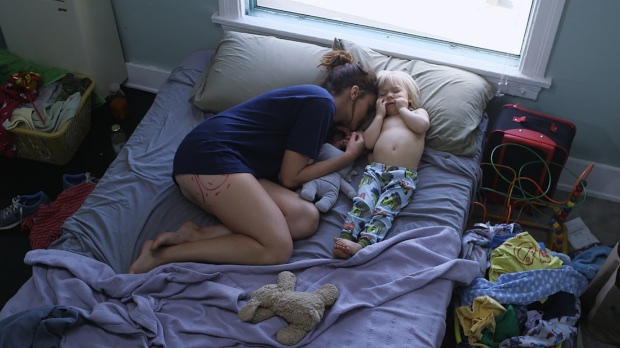 Back to selection
Back to selection
Quyen Tran on Shooting Frankie Shaw’s Sundance-Winning SMILF
 SMILF
SMILF Frankie Shaw’s short film SMILF won the Short Film Jury Award at this year’s Sundance Film Festival. It’s a funny and revealing comedy about a young mom struggling to connect to her old sexual self while being homebound caring for her young son. L.A.-based cinematographer Quyen Tran shot the film, and below she discusses shooting coverage with only one actor, working with one light and filming while nearly nine months pregnant.
Filmmaker: How and why did you wind up being the cinematographer of your film? What were the factors and attributes that led to your being hired for this job?
Tran: The director and I had talked about shooting a short two years earlier that never went, so we kept in touch. We also have a lot of mutual friends, and I had a shot a short film for her boyfriend a couple years earlier. I really love working with and supporting other women, so when she wrote this script and sent it to me, I was more than thrilled to be working with a female director. At the time I was also 35 weeks pregnant with my second child, so that made for a fun time! I immediately connected to the script because of the subject matter. Well, I at least could understand where the single mom was coming from, knowing how your life revolves around your little ones.
Filmmaker: What were your artistic goals on this film, and how did you realize them? How did you want your cinematography to enhance the film’s storytelling and treatment of its characters?
Tran: Since the film came together incredibly fast, Frankie and I talked about shooting two cameras in order to capture the improv. Both she and Thomas are incredible improvisers, and shooting two cameras really saved us in the edit, since each take was different. Our goal was to capture as much of the dialogue without having to compromise on lighting and composition.
Filmmaker: What were the biggest challenges posed by production to those goals?
Tran: We had a very limited amount of time with our actor Thomas, so we had to shoot him out super quick. Unfortunately, that meant covering Frankie’s single without Thomas, but luckily she’s such a great actress that she pulled it off seamlessly.
Filmmaker: What camera did you shoot on? Why did you choose the camera that you did? What lenses did you use?
Tran: We had no budget for the film, so we shot on my personal camera. I own a Canon C500 which I use for documentary work, and it seemed perfect for this film since we were going for a naturalistic vibe. We shot on Zeiss primes that my second camera borrowed from his buddy.
Filmmaker: Describe your approach to lighting.
Tran: We were shooting in a tiny second story apartment with an even smaller bathroom, so I had to make use of natural light. The big window provided southern exposure, so that became our key light. I brought up room tone with a Joker 800W, our only light. We wanted a very natural look, so I tried to use natural light as much as pososble
Filmmaker: What was the most difficult scene to realize and why? And how did you do it?
Tran: I was worried about the bathroom scene just because it was incredibly tight in there. We couldn’t get singles, and Thomas had another appointment, so we blocked it so that the actors were stacked in a two shot.
Filmmaker: Finally, describe the finishing of the film. How much of your look was “baked in” versus realized in the DI?
Tran: We baked in the look since we had no idea we would be able to afford a DI. We wanted natural skin tones, which the C500 did a great job at capturing. Essentially all we had to do was match shot/reverses and increase the contest slightly.
